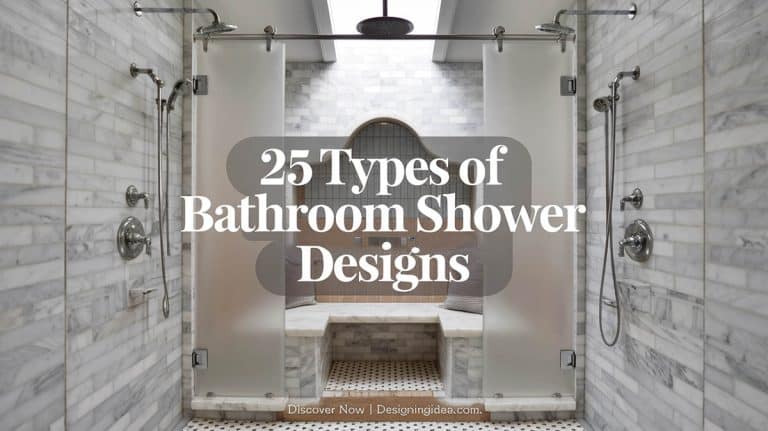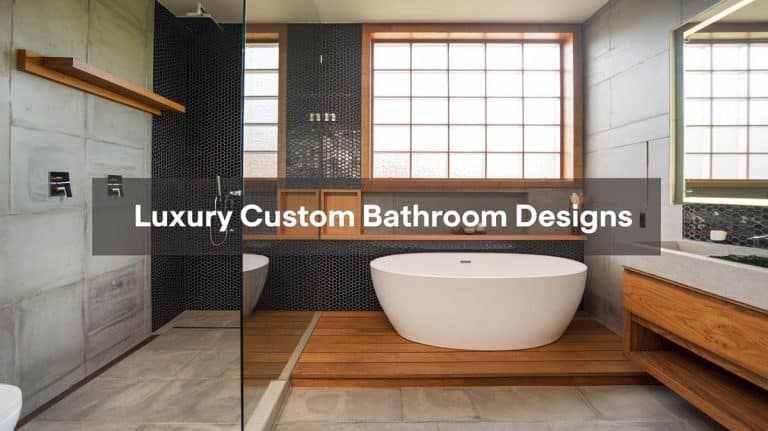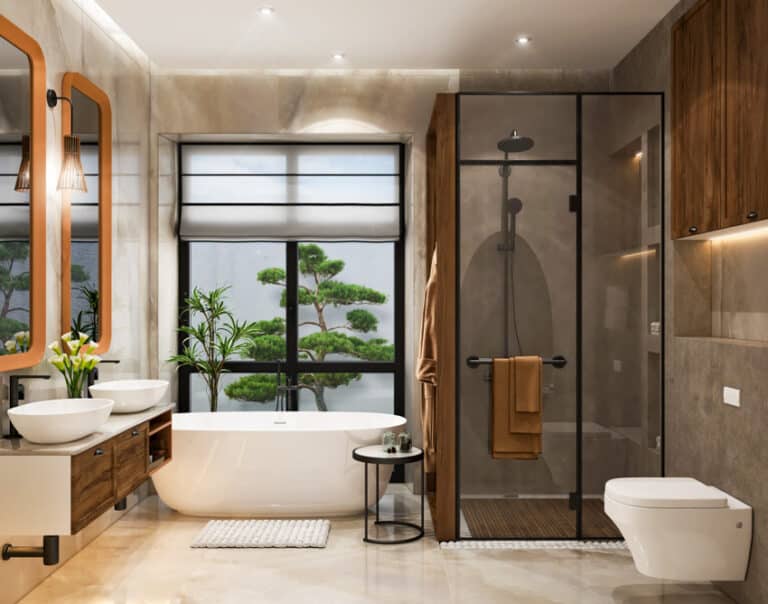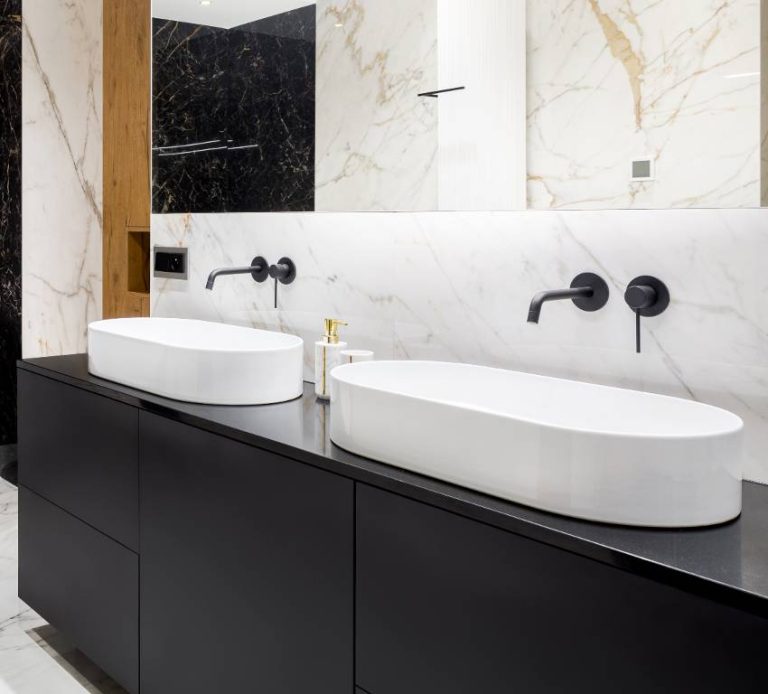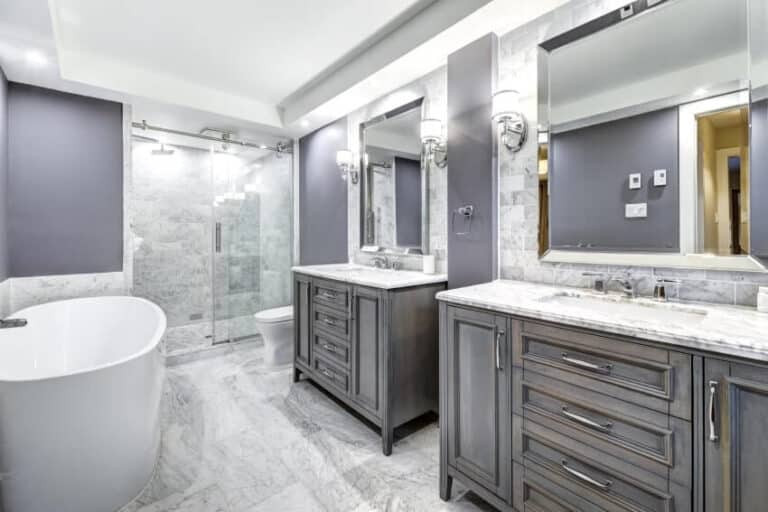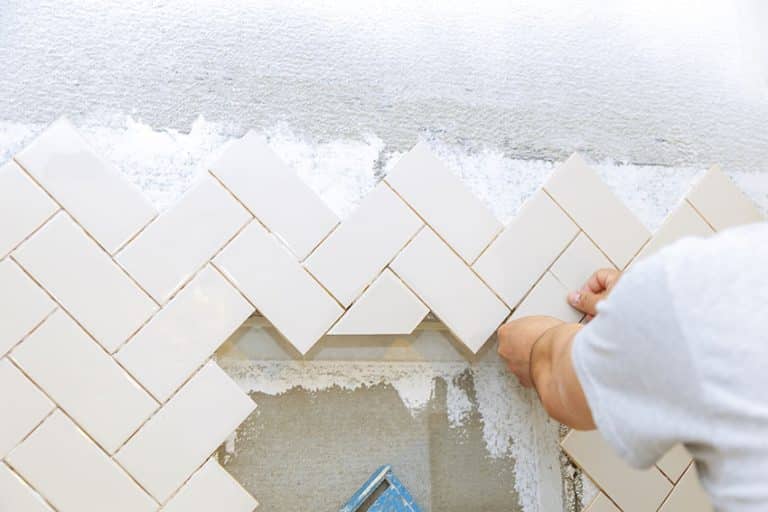Designer Tips For Minimalist Bathroom Designs You’ll Love
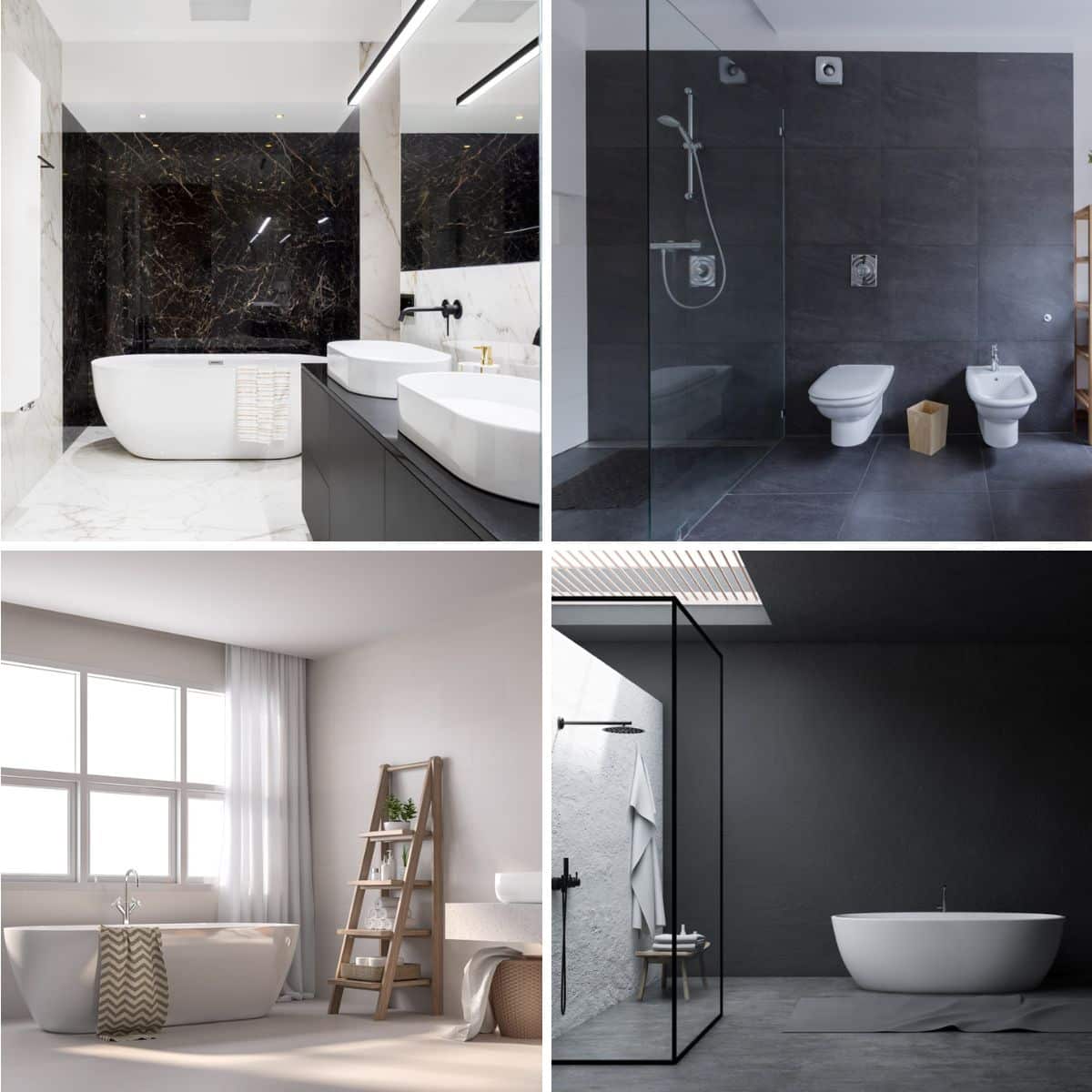
More than just having less furniture or decor, minimalism, when applied in designed interiors is more complex than we think, as expressed by the lifestyle or movement of minimalist principles. Minimalist bathroom designs should also be highly functional, despite having a minimum amount of elements.
Anatomy of a Minimalist Bathroom
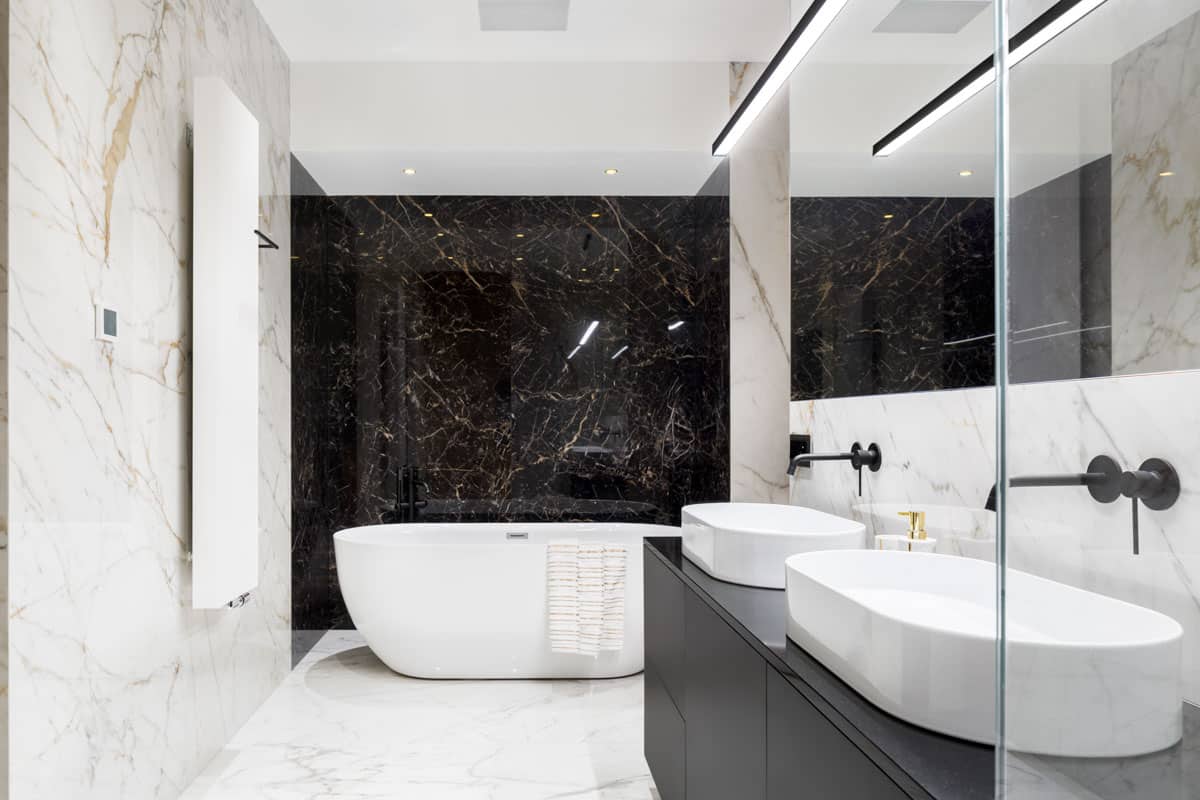
There is simplicity in elegance, and as Mies Van der Rohe says, less is more. Since its rise in the art community, minimalism has become the “mainstream” style of architecture and interiors and continues to be applied in our contemporary homes. We take a look below at what makes a bathroom minimalist.
Color Palette: The early stage of planning your minimalist bathroom usually starts off with what colors to use or combine, and knowing the color choice usually makes it easier to choose other elements. Colors can inspire designs and set the mood or stage of your design.
Achromatic Color Scheme: While monochromatic has become synonymous with monochromatic, many may not be familiar with the achromatic color scheme, which is a common color combination in minimalism.
An achromatic color scheme is when it combines achromatic colors, namely black, white, and shades of gray, or a full-value tonal range of gray. These colors are considered neutrals since they do not contain any chroma or hue.
For a minimalist bathroom that uses an achromatic color scheme, take a cue from industrial minimalism interiors. The neutrals are great at adding depth and defining areas by utilizing light with the achromatic colors.
Monochromatic Color scheme: The use of different shades of one single color eliminates the need to mix and match different colors. Visually, it is more relaxing and has that needed variation, but at the same time, it has a harmonious quality due to the similar base color. This also allows other elements, such as texture, to be more noticeable as it has a backdrop with a single color.
Though you can choose virtually whatever color you prefer, a minimalist bathroom design feels more relaxed with light and neutral tones. A monochromatic color scheme is great when considering small bathroom ideas for your home, as a single color means fewer competing colors.
Neutral color scheme: Neutral colors are a staple when it comes to painting the walls, ceiling, or floor, as these colors can match with other colors while keeping a backdrop that’s easy on the eyes. Neutrals allow other elements to pop, and depending on the mood or preference, you can choose between warm and cool neutrals.
Two-Color Scheme: A two-color scheme narrows down elements into only two colors, usually using solid colors. A minimalist color palette with a white and lavender combination, for instance, creates a cool and relaxing vibe and allows other bathroom elements to become noticeable.
Lighting: Light is interwoven with the design to achieve the intended mood of the space. In minimalism, lighting is popularly used to add depth and emphasize the sleek and simplified profiles of elements, as seen in falling water countertops when LED lights are installed along the countertop profile.
Light used also aims to create an airy feeling in the space, and minimalism primarily utilizes natural light. A designer would find ways to allow natural light into your interior.
Flooring: Minimalist flooring presents an opportunity to add texture. In a bathroom setting, vinyl planks or laminated engineered floors can simulate the look of wood while keeping an impervious flooring surface. Light-colored wood is a preferred tone when it comes to minimalist bathrooms, as it serves as a grounding color while keeping a light and airy atmosphere in the space.
Fixtures: Bathroom fixtures for minimalist designs are characterized by simple and sleek hardware finishes and can be integrated with smart features such as heat sensors that eliminate the need for levers or handles. The pared-down version of fixtures lessens visual distractions.
The streamlined aesthetic is accompanied by modern finishes such as matte black or chrome materials. Floating vanities and wall mounted faucets are popular because they free up the lower space and creates a clean and airy look.
Storage: Hidden compartments and niches are popular in minimalist bathrooms for organization. A hidden cabinet behind the mirror, for instance, saves space and keeps your toiletries out of the way.
Minimizing spaces in your home helps you achieve the greatest level of peace and relaxation. The bathroom is a great example of this. Getting rid of the clutter in your bathroom will make it seem more spacious. – Summary of Joshua Becker’s The Minimalist Home, Everest Media
Multi-purpose items such as vanity stools with storage are popular in chic minimal bathrooms. Customized storage that is tailor-made to fit your space and needs is the best option for minimalist interiors.
Accessories: While minimalism is all about keeping necessary items only as much as possible, it doesn’t mean you don’t have the option of choosing accessories to enhance the quality of your space. You do need to choose accessories that have simple geometric profiles, such as square or rectangles.
Aside from keeping it simple, the fewer accessories, the better. Accessories that are neutral or pale toned are great in a relaxing spa-like setting since its more relaxing to the eyes rather than bold tones.
Also, focus on the quality of your accessories. Multi-purpose or multi-use accessories are great for maximizing the space and providing the convenience of use in your bathroom. For instance, sleek glass holders give a luxurious look to your modern layout while being an easy-to-clean material.
Textures: One of the main qualities of minimalism is having “no makeup” on surfaces. Choose materials that have an innate texture. Bare natural stone or unpainted concrete walls are popular options for adding a tactile surface. The use of bare concrete was popularized in the Brutalist movement.
Introduce a few pieces of organic material in your room to offset the clean and sleek surfaces. Woven rugs made of jute or storage baskets made of wicker are organic materials you can easily integrate into a modern interior. This juxtaposition of smooth and sleek vs. tactile and earthy creates a more welcoming atmosphere in your bathroom.

Materials: Minimalist bathroom designs incorporate modern materials and the two main popular natural materials, wood and stone. Concrete, glass, and metal are used extensively, sometimes with sometimes integration of leather and plastic materials. Liquid stone and concrete can be shaped and formed into any design, making them versatile materials.
As seen, most brutalist and contemporary homes are used with concrete. However, while brutalist walls are untreated, you will need to seal off your concrete if you ever you will be using it as a vanity countertop or as flooring, walling, or ceiling to prevent mold buildup. This will also increase its life service.
Profile/Lines: Choose elements that have simple geometric lines, such as a square or rectangle. A circular mirror is a popular option for vanities and adds variety to your rectangular or square elements. A thinner version of your floating vanity sinks are plane sinks.
These are sinks that usually have 2 to 3 inches of thickness and have their sink sloped towards the mounted side. The simple design creates a clean and uncluttered look in your bathroom.
Plane sinks are going to be popular due to their clean and sleek appearance. You’ll also find a version with a hidden sink drain that uses a bottle trap instead of your space-consuming p-trap.
Space Utilization: Like other minimalist interiors, a bathroom aiming for that minimalistic style typically utilizes an open floor plan. This means open and flowing spaces.
• Use transparent or translucent surfaces, especially for room dividers.
• Take advantage of reflective and smooth surfaces by creating an illusion of spaciousness.
• Consider low-profile bathtubs that take up less floor space. Slipper tubs for instance are luxurious and take up less room than a traditional built-in model.
Windows that are located higher not only provide privacy but also make it easier to utilize vertical spaces. If windows are not possible, explore other options, such as solar tubes or a bathroom skylight, to capture natural light.
• Choose square or rectangular-shaped furniture, as it is easy to fit in corners.
Minimalist Materials and Palette Choices
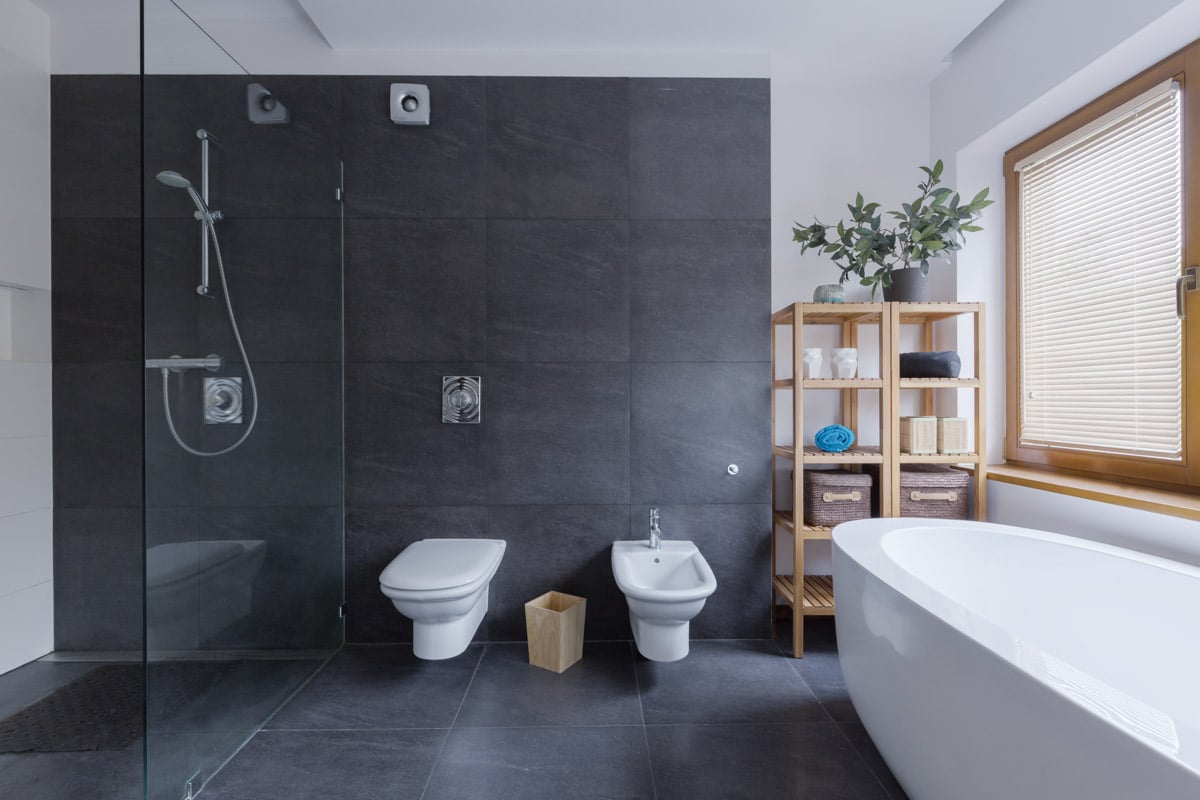
While pale and neutral tones have become the staple when it comes to minimalistic interiors, we do see the inclusion of earthy tones and strong backdrops such as black, charcoal gray, and metallic surfaces. Bejeweled colors such as emerald green, ruby tones, sapphire blue, and tangerine are injected into these solemn spaces.
Earthy tone palette: This color combines colors that are inspired by nature, such as sage green, dessert beige, and other muted greens and beiges.
Modern materials: Chrome and stainless steel a favorite hardware materials also due to their durability and work well with glass, concrete, wood, leather, and other modern materials. For this reason, you’ll find sleek shower glass dividers and in-bathroom hardware.
Luxury stones: One of the advantages of having a minimalist style is that you can easily showcase natural textures such as marble or granite. The soft swirls and whimsy stretch of tile veining are eye-catching and create richness in a minimalist floor plan.
Canvas and Wool: Another way to balance the overall look of your bathroom interior is to add softer materials. White faux fur rugs are popular, as well as canvas storage bins, which add variety to your room’s style without overpowering other elements. Other bathroom rug fabrics you can include are linen, silk, and other synthetic fibers.
Maximizing Interior Space Without Adding More
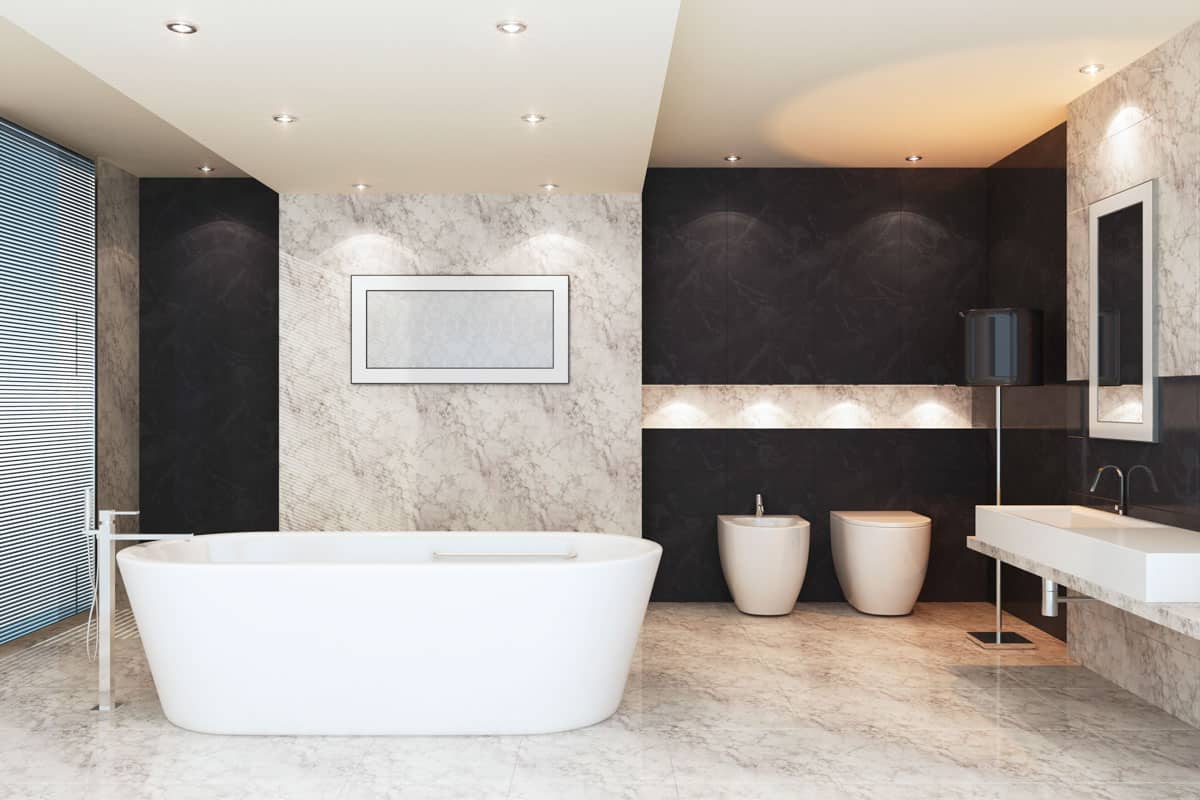
Using less décor and unnecessary elements in your minimalist bathroom lessens space usage. Small layouts that adopt this type of style have the advantage of maximizing space without the need to add more square footage.
Strategies:
• Remove unnecessary items in your bathroom to free up some space.
• Use multi-purpose furniture or accessories.
• Utilize your vertical space.
• Take advantage of the neutral tones and sleek surfaces for that optical illusion of having more space.
• Stackable and foldable storage items can save space while ensuring you have enough storage area.
• Opt for built-in storage as well as niches. Having a storage or fixture built to accommodate the area available means you can occupy the space fully and according to your preference and use.
Minimalist Design With Maximum Functionality
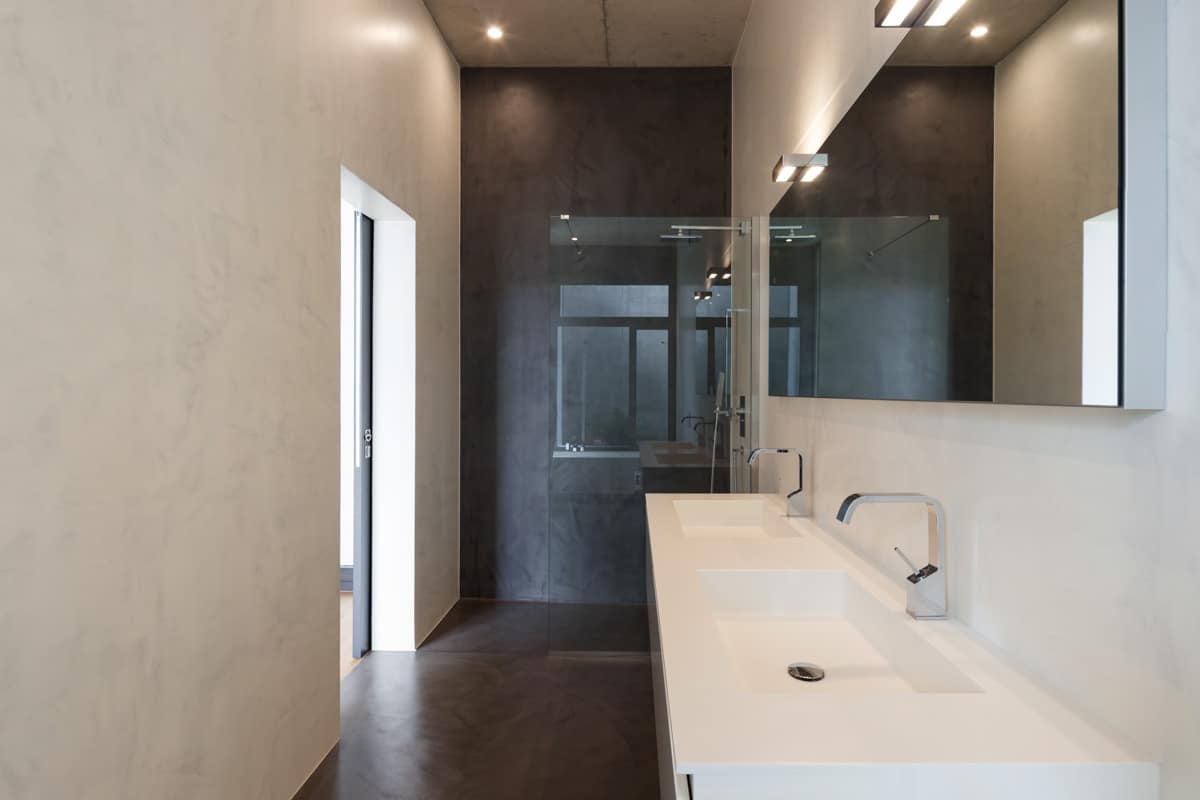
Your minimalist bathroom design aims to have that maximum functionality, and it starts with having a flexible space. When you are still in the planning stage for a new build, you can choose your bathroom perimeter. A square or rectangular plan is the easiest shape to configure your elements. You may also want to consider an open plan with sleek room dividers, such as glass.
Maximizing the natural light is another important factor in creating a functional minimalist bathroom. Properly designed light minimizes the need for additional luminaires and the adjustment of areas.
Personalizing Your Minimalist Room

Thoughtful incorporation of items into your bathroom space is the key to personalizing your minimal space. You can select meaningful pieces, such as objects that are sentimental to you. Personalized items, such as a personalized towel and accessories, are a great way to create a unique space that’s tailor-made for your use.
A single artwork or sculpture of your favorite artist, color, or character is a great way to integrate your style into your minimalist space. A potted plant and accessories is another great way to soften and give character to a minimalist bathroom.
Checklists: For decluttering and planning
1. Planning Checklist
• Purge unused and duplicate products, which include expired products, especially medicines.
• Lessen décor items. A general rule is to have at least one, but not more than three, in a small bathroom to have a greater visual impact.
• Limit toiletries. If possible, place your extra toiletries in your laundry or other functional rooms with larger storage spaces.
• Don’t place free samples shampoos or other toiletries in the bathroom. You can, however, choose to place all sample items in a poach bag or basket.
• Don’t forget to plan your waste bin location. Embedded waste bins, pullouts, or recessed bins have a sleek and modern look and can be integrated into your minimalist counters or walls.
• Remove toilet packaging to reduce the space occupied by your toiletries.
• Do periodic cleanings of your bathroom. An easily accessible bin will encourage you to clean your room regularly.
• Consider built-in or customized storage for your bathroom, especially when it is a newly built interior.
2. Decluttering Checklist (Download this Bathroom-Decluttering-Checklist here)
• As a prerequisite to organizing your bathroom, be ready with your cleaning tools. Also, prepare trash bags and protective gear such as gloves and, if needed, a gas mask.
• Prepare bins or containers where the sizes will depend on how many items you have in your bathroom. Label these containers according to where they are classified, such as toiletries, kids’ toys, décor, and linens. If you have smaller items, you can further categorize your items such as shampoo, soap, makeup, oils, etc.
• Assign a time when you are unlikely to be disturbed when cleaning your bathroom if you are planning for a general clean. Then, assign a scheduled time for maintenance, such as setting aside once a week or twice a week.
• Prepare a box to place unnecessary items that may be eventually used in the future to be set aside. You can also donate items to charity if you prefer.
• Remove all items from the room, including electronic gadgets and mounted hooks or bins.
• While removing items, place them in the assigned box or containers with labels.
• Once you have purged items from the removed items, it’s time to clean up your bathroom.
• After a thorough cleaning, return your items. You may choose to have vertical or multi-purpose organizers and storage trays to house your toiletries.
• Utilize storage by finding ways to use unusable or odd spaces, such as over-the-door organizers, wall-mounted shelves, and stackable ottomans.
See more related content in our article about beautiful bathroom styles on this page.

